Hot Sauce Recipe
My hot sauce recipe is full of flavor and surprisingly simple to make! Follow my easy directions for a traditional fermented hot sauce or a quick-cook version.
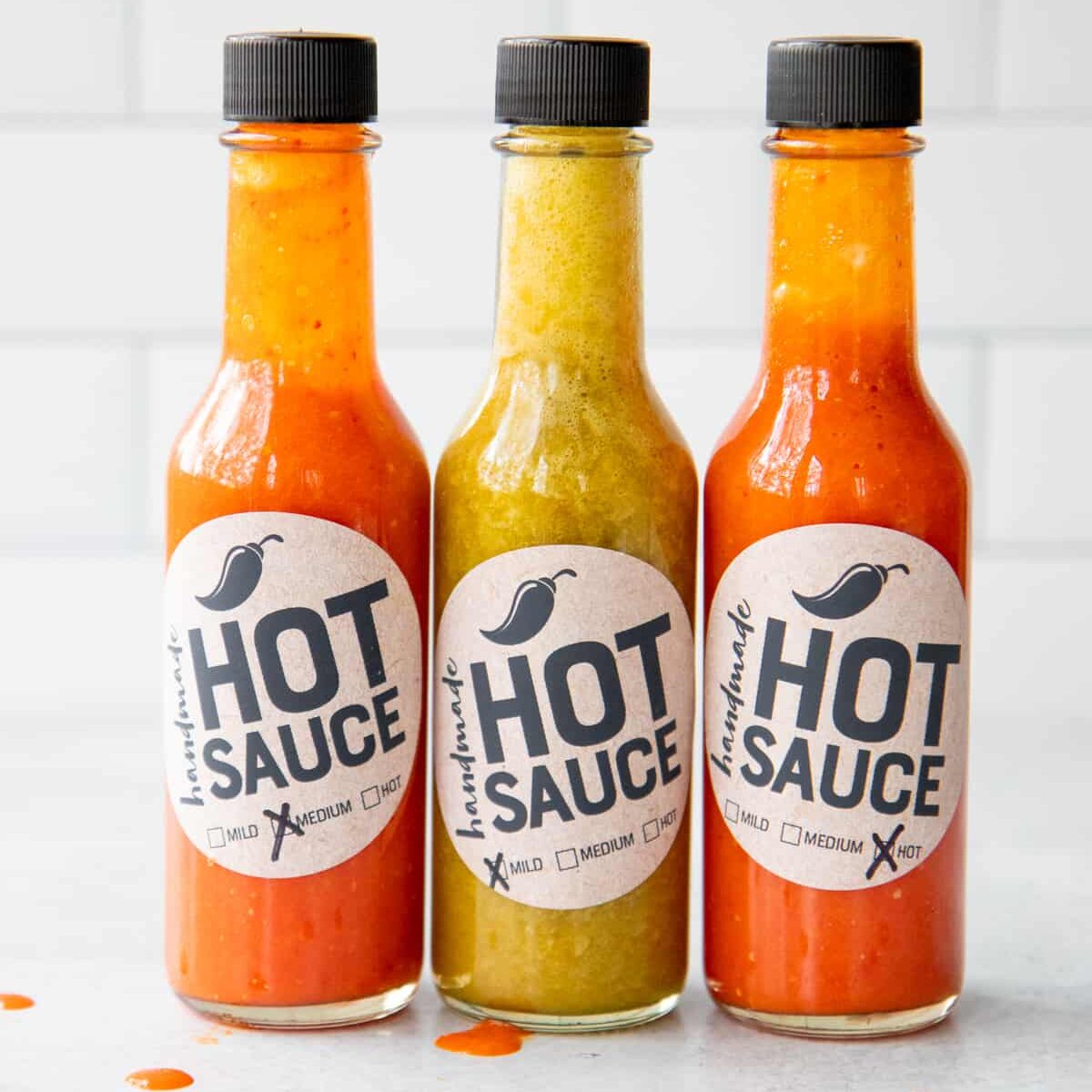
Why You’ll Love This Recipe
I use this exact recipe to make a big batch of customized hot sauce every single summer! I’ve fine-tuned this recipe and method over almost a decade, so you know it’ll turn out great when you try it. Here’s why you’ll love it:
- It’s shockingly simple to make homemade hot sauce! I promise you can do this.
- I include both a traditional fermented and a quick-cook version of hot sauce, so you can choose your own adventure when it comes to hot sauce creation.
- This recipe is infinitely customizable. No matter if you like it super mild or tears-in-your-eyes spicy, you can make your hot sauce your own.
- It’s a great way to use up a bounty of hot peppers or sweet peppers!
- This recipe is kitchen-tested for success. I’ve been making this exact recipe in my own kitchen (and gifting the results to rave reviews) for years, so you know you can trust it to turn out right.
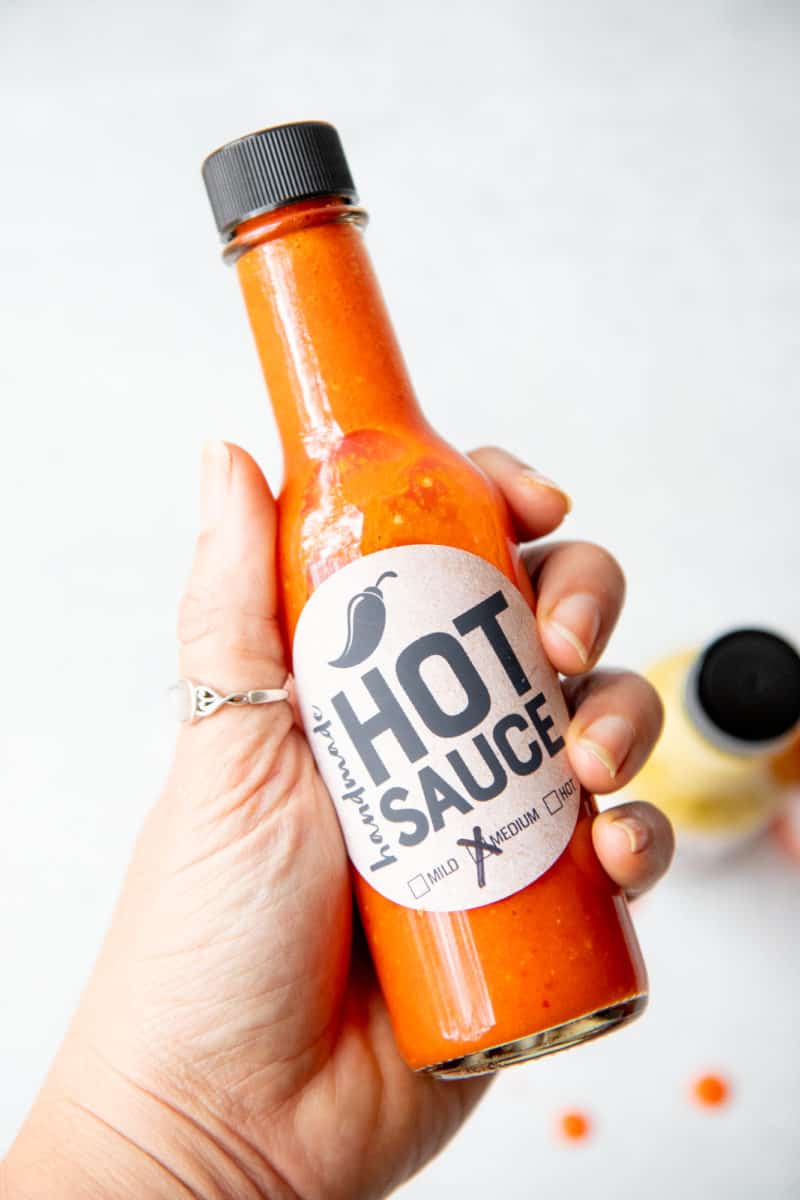
What You’ll Need
Ingredients
You really don’t need many ingredients to get starting making this hot sauce. Here’s what you’ll need on hand:
- Peppers: Jalapeños, reapers, Thai chilies, habanero, bell, cayenne, ghost peppers, serranos, OH MY. Which peppers you use really depends on your personal heat tolerance and the flavor profile you’re looking for.
- Garlic: A hefty dose of garlic adds a nice under layer of flavor to your hot sauce.
- Water: I recommend filtered water (especially if you are following our fermentation version) to make sure your flavor is crisp as possible.
- Salt: I like to use sea salt here.
- Apple cider vinegar: This gives your hot sauce the added tang that you’re used to.
- Honey or maple syrup: This is optional, but I find adding just a touch of sweetness helps balance the hot sauce flavor.
- Xanthan gum (optional): This emulsifier helps keep your hot sauce from separating. It’s 100% optional, but just know you’ll have to give your hot sauce a good shake before using without the xanthan gum.
Supplies
You probably have all the supplies on hand to make this recipe, but if you want a few special items to make the project easier, here’s what to grab:
- Fermentation weights and lids: If you want to make the fermented version of this recipe, some fermentation weights and lids make the process much easier.
- Wide mouth canning jars: To go with your fermenting weights and lids.
- Hot sauce bottles: You can put your hot sauce into any sealed container, but these hot sauce bottles are perfect for gifting.
Watch The Video
How to Make Hot Sauce (Fermented Version)
Follow along with my numbered instructions and step-by-step photos to see exactly how to make fermented hot sauce. Don’t get intimidated! This is a super easy fermentation—even easier than sauerkraut—and it gives a complex, interesting flavor to the hot sauce. Here’s how easy it is to ferment your own hot sauce:
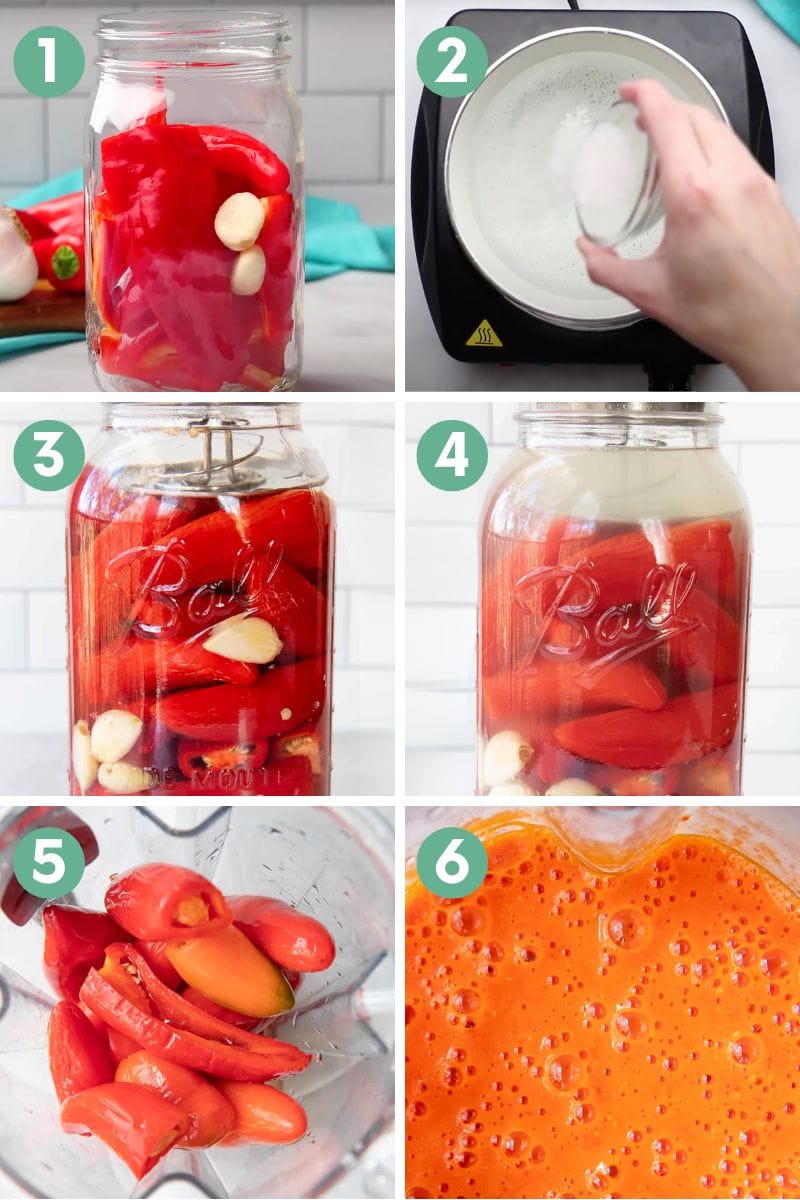
- Combine peppers and garlic in a wide-mouth canning jar.
- Make the brine by combining the water and salt in a saucepan and heating until salt is melted. Let cool
- Cover the pepper and garlic with the brine, fit with a fermentation weight and lid, and let ferment out of direct sunlight for 5-7 days.
- The brine will look cloudy when it’s ready—this means the fermentation is working!
- Drain the peppers, reserving the brine. Combine the peppers and garlic, vinegar, honey or maple syrup, and 1 cup of brine in a blender. Blend until silky smooth, adding in additional brine to thin out if necessary.
- If you using the xanthan gum, sprinkle it in while the blender is running and blend for an additional minute.
How to Make Hot Sauce (Quick-Cook Version)
If fermentation isn’t your thing, I provide step-by-step instructions for a quick cook version below. It doesn’t have quite the complex flavor of the fermented version, but it’s done in a jiffy! It also doesn’t last as long in the fridge—make sure you use your unfermented hot sauce within a couple of weeks.
- Combine the peppers, garlic, water, salt, vinegar, and honey or maple syrup in a medium pan. Bring to a boil and simmer until the peppers and garlic have softened.
- Pour mixture into a blender and blend until very smooth.
- While the blender is running, sprinkle in the xanthan gum and blend for an additional minute.

Heat and Flavor Variations
Feel free to mix and match different types of peppers to get the flavors and heat levels you desire, but make sure you stick to the same color family. Why? Well, if not, you’re going to end up with a brown hot sauce—which, trust me, doesn’t look so appetizing when drizzled on your food. The two hot sauces in the photos here were made with these mixes:
- Red Medium Hot Sauce: Red bell peppers, red cayenne peppers, and red jalapeño peppers (we let jalapeños ripen until they were red)
- Green Mild Hot Sauce: Green bell peppers, green jalapeños, and poblanos
Whatever you choose, remember that you can always add more spice in, but you can never take it out once it’s been blended. I tend to like a more mild hot sauce, so I start with a 3:1 ratio of sweet peppers to hot peppers. When using a milder hot pepper, like jalapeño, I cheat to more like 2:1 or 1:1. Some folks use nothing but hot peppers—so it really is up to you to pick your poison here.

Want to save this recipe?
Storage and Preservation Directions
The beauty of this acidic hot sauce is that it’ll easily last quite awhile in the fridge! Our quick cook version lasts in the fridge for 2-3 weeks, and the fermented version will last much longer—easily 3-6 months. Thank you, beneficial bacteria!
If you’d like to preserve your hot sauce for longer storage, you can either freeze it or process it in a waterbath canner (if you choose to can hot sauce, use a recipe that has been tested and proven safe for canning instead of ours). A caveat here: the beneficial bacteria created in the fermented version will be killed off by the high heat from the canning process. It’ll still be delicious, it just won’t add any probiotics into your diet.
Hot Sauce Tips and Tricks
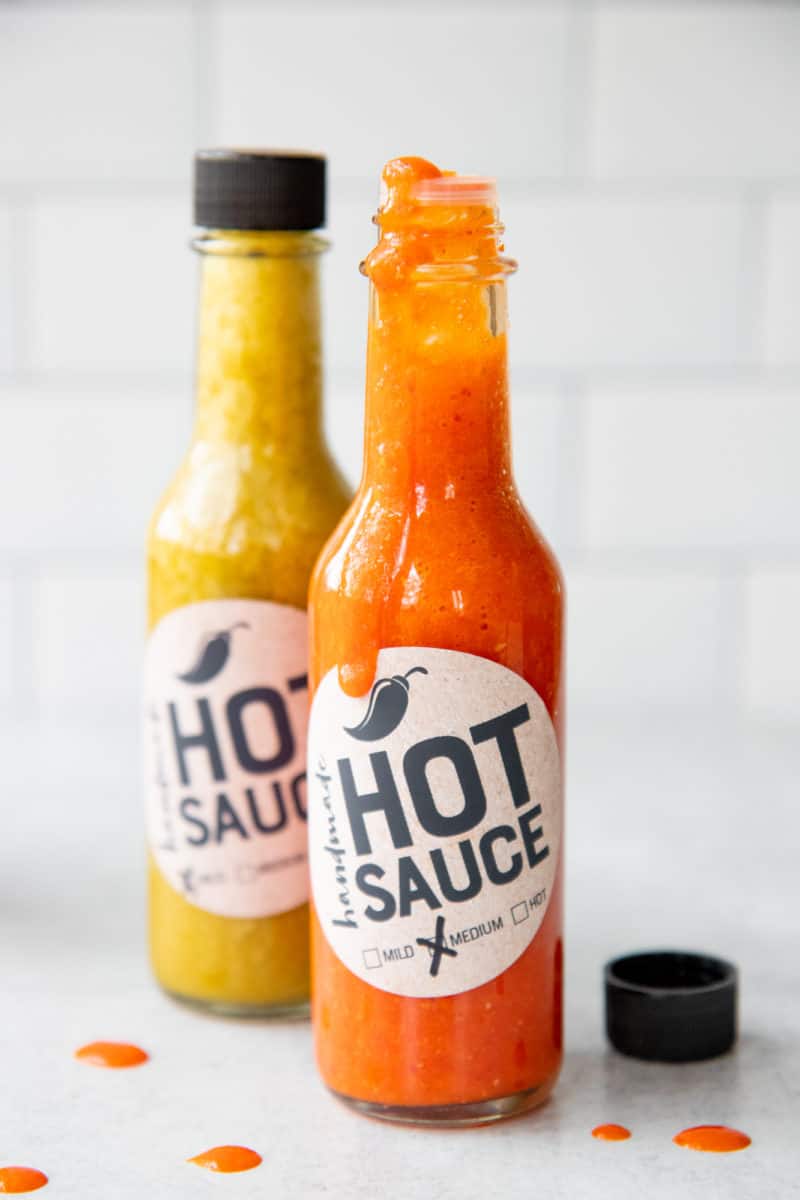
Frequently Asked Questions
What kind of vinegar is best for hot sauce?
You can use either white distilled vinegar or apple cider vinegar here. I prefer the slight fruity flavor of apple cider!
How to make hot sauce without fermenting?
If you don’t want to make fermented hot sauce, you can quick cook the ingredients on the stove and bottle them (and enjoy your sauce the same day).
Looking for more fun fermentation recipes?
Fermentation is a great way to add healthy probiotics to your diet, and it’s just plain fun to experiment! Here’s a few of my tried-and-true fermentation recipes to get you started:
- Homemade Sauerkraut Recipe :If you’re new to fermenting, sauerkraut is the perfect place to start.
- Strawberry Wine Recipe: If you’ve never made fruit wine before, you’ve got to try it. The process is straightforward, and the results are absolutely amazing!
- How to Make Yogurt: Making your own yogurt at home is super easy and can save you a ton of cash. I’ve done it for years!
Love this recipe? Leave a review!
If you love this recipe as much as I do, make sure to leave a 5-star review below to help others.
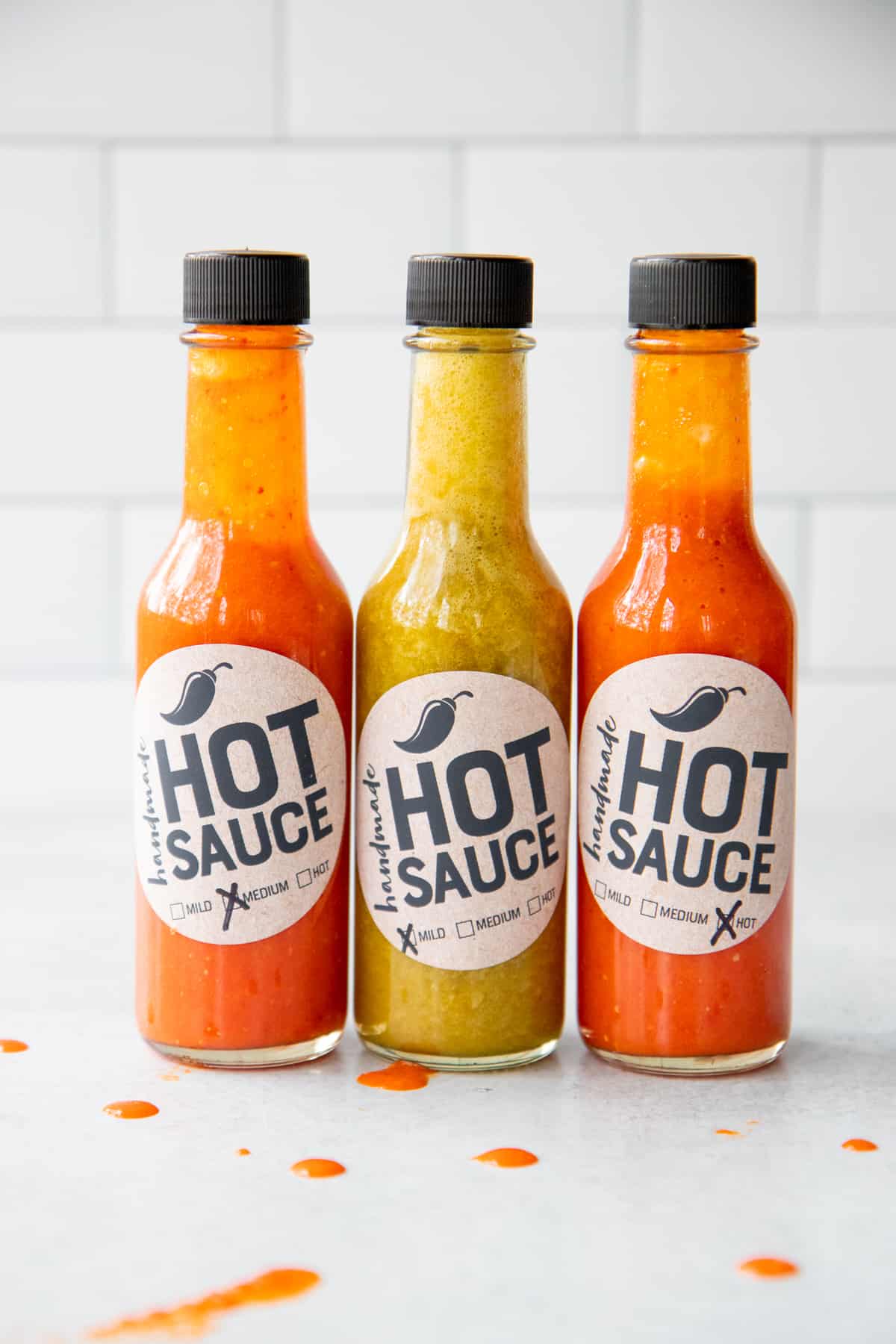
Homemade Hot Sauce Recipe (Fermented or Quick Cook)
Ingredients
- 1 ½ pounds peppers of your choosing a mix of sweet peppers and hot peppers, tops/stems removed, halved
- 6 cloves garlic peeled
- 4 cups filtered water
- 4 teaspoons sea salt
- ⅓ cup apple cider vinegar
- 1 tablespoon honey or maple syrup optional
- ½ teaspoon xanthan gum optional (see notes)
Instructions
For the Fermented Version
- Place the peppers and garlic in a clean wide-mouth quart canning jar. Set aside.
- To make the brine, heat the filtered water and sea salt in a medium saucepan until the salt has dissolved completely. Let cool to room temperature.
- Pour the brine over the peppers and garlic, completely submerging them. If you run out of brine, you can make more by mixing 1 cup of warm filtered water with 1 teaspoon of sea salt.
- Fit the jar with a fermentation lid or cheesecloth secured with a rubber band (see notes on weighing down the peppers if using cheesecloth). Place in a warm, dark spot for 5-7 days, or until the brine looks cloudy and small bubbles begin to appear when you tap the side of the jar. Make sure the peppers stay submerged under the brine during the entire fermentation process to prevent mold-growth.
- When the fermentation time is up, strain the brine, reserving it. Place the fermented peppers and garlic in a blender, and add in 1 cup of the brine, plus the apple cider vinegar, and honey or maple syrup, if using. Blend until completely smooth, adding in additional brine to reach the desired thickness. The hot sauce will thicken in the fridge.
- While the blender is running, sprinkle in the xanthan gum, if using, and blend for an additional minute.
- Transfer to a bottle and store in the fridge for 3-6 months.
For the Quick Cooked Version
- Combine the peppers, garlic, 2 cups of water, 2 teaspoons of sea salt, apple cider vinegar, and honey or maple syrup, if using, in a medium pan over medium-high heat. Bring to a boil, reduce heat, and simmer for 10-15 minutes, or until the peppers and garlic have softened.
- Pour mixture into a blender (making sure to leave the cover vent open, but covered with a kitchen towel) and blend until very smooth.
- While the blender is running, sprinkle in the xanthan gum, if using, and blend for an additional minute.
- Transfer mixture to a squeeze bottle and store in the fridge for 2-3 weeks.
Video
Notes
- If you choose to use cheesecloth during fermentation, you’ll need to use some sort of weight to keep the peppers submerged under the brine to prevent mold growth. You can purchase specialty weights to do this, or fill a zip-top sandwich bag with water and submerge it in the top of the jar.
- In this recipe, xanthan gum works as an emulsifier, stablizer, and thickener. It is 100% optional. If you choose not to use it, your hot sauce will separate in the fridge. Just give it a good shake each time you go to use it.
- The hot sauce will thicken considerably in the fridge, so keep that in mind as you decide on the consistency while blending.
- Depending on the power of your blender, your hot sauce may be foamy when you’re finished blending. If so, let the hot sauce rest for 15-20 minutes, then scrape off any foam before bottling.
- Get your printable labels here.




Looking for more gift ideas?
Check out our new cookbook:
Gifts in Jars
This full-color cookbook has 80 quick and easy handmade food gift ideas for every budget!
Many links on this site are affiliate links. As an Amazon Associate, we earn from your qualifying purchases at no extra cost to you.